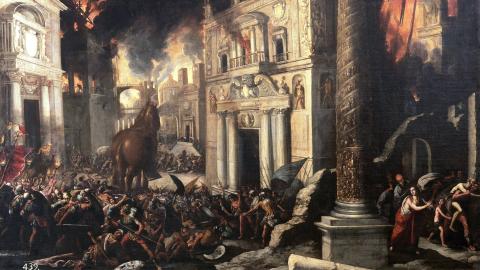Gawain
In the show
Bold, devout and lethal, Gawain cuts a formidable figure – literally. His skills as a swordsman are second to none, even among his fellow knights, and he stands apart as one of the most fearsome warriors the order has ever produced. He backs up his skills on the battlefield with a heartfelt devotion to the Templar brotherhood, and an iron-clad loyalty to his friend and fellow Templar, Landry du Lauzon.
But it is this loyalty that will set Gawain on a dark and turbulent path. Shot in the leg with an arrow while protecting Landry during a fierce skirmish, Gawain is forced to accept he can never be the warrior he once was. Indeed, he’s bluntly dubbed a “hindrance” by the very friend whose life he saved. His pride hurt, and his very sense of self dealt a devastating blow, Gawain sets his sights on the Holy Grail, the legendary relic which he hopes will have the potential to heal his injury and restore his place in the Templar order. But his obsession could well lead him to betray the moral code and chivalry he held so dear…
In folklore
The Gawain of popular folklore is not a Templar, but he is a knight. One of King Arthur’s fabled Knights of the Round Table, in fact, playing a key role in the sagas from the very beginning. It’s important to remember that Arthurian lore as we know it today evolved slowly over time, encompassing the works of many different storytellers through the ages. One of the earliest was Geoffrey of Monmouth, a 12th Century writer whose sweeping work, The History of the Kings of Britain, was the first to really cement the basic elements of the Arthur story – elements such as Merlin the wizard, and the knight who would become known as Gawain.
Gawain appears again and again in later versions of the saga, including the works of
Chrétien de Troyes, who brought in the dashing knight Lancelot and introduced the tragic Arthur-Guinevere-Lancelot love triangle. Gawain himself is more of a supporting figure in many of the stories, and usually exemplifies chivalry at its finest. Honourable, courteous and loyal, he is the very model of the dashing knight – just as the Templar Gawain of Knightfall is to begin with.
But, just as the Templar Gawain gradually takes on a darker turn in Knightfall, so too do we see the Arthurian Gawain shift and morph in the annals of folklore. Originally presented as a paragon of knightly virtue, the character is depicted in a more complex, morally questionable light in other versions of the Arthurian saga. We see a prouder, more materialistic knight, effectively corrupted by the world around him. In one account, known as the Prose Tristan, Gawain crosses the moral line into outright savagery.
There is also an account of an enraged Gawain launching a vengeful vendetta against Lancelot, after the latter causes the deaths of Gawain’s brothers while trying to rescue Queen Guinevere (who had been sentenced to death for her illicit affair with Lancelot).
Yet, despite these darker depictions, the most celebrated incarnation of Gawain sees him at his most noble and virtuous – in the great poem Sir Gawain and the Green Knight. Dating back to the 14th Century, penned by a tantalizingly unknown author, it’s a tale that beautifully encapsulates the chivalry and romance of the Arthurian age. In it, a mysterious, magical figure – the Green Knight – bursts into Arthur’s court and challenges one of the knights to cut off his head, on the condition that the knight will agree to visit him one year later to receive an identical blow.
Gawain rises to the challenge, delivering the death blow, only to watch the Green Knight calmly pick up his head and depart. One year later, as agreed, Gawain rides out to meet his fate, and is subjected to adventures and temptations which challenge his honesty, honour and knightly valour. He survives his ultimate confrontation with the Green Knight, who is revealed to have been testing him all along.
This is a very different Gawain to the dark, vengeful, brutal figure in other Arthurian tales. And it looks likely that the Templar Gawain of Knightfall – heroic but embittered, loyal yet headstrong – will be every bit as complex and unpredictable.
















